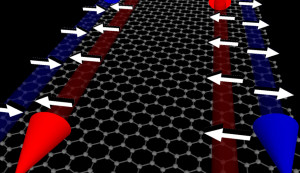Graphene could be good for Quantum Computing
on

Researchers experimenting with the properties of Graphene have discovered that when the single-atom-thick sheet is exposed to extreme low temperatures and high magnetic field it has the ability to filter electrons according to their spin direction.
At room temperature and with no magnetic field the flake of graphene functions as a normal conductor with electrons flowing throughout the sheet. With the application of a magnetic field perpendicular to the sheet the electrons migrate out to the sheet edges while the rest of the sheet has the properties of an insulator. Current flow around the edges is either clockwise or anticlockwise depending on the orientation of the field (known as the quantum Hall effect).
When the MIT researchers switched a second magnetic field in the same plane as the Graphene sheet they found that electrons move around the edge in either clockwise or counterclockwise direction depending on the electron’s direction of spin. Researcher Andrea Young explained "We created an unusual kind of conductor along the edge, virtually a one dimensional wire, the segregation of electrons according to spin is a normal feature of topological insulators, but graphene is not normally a topological insulator. We're getting the same effect in a very different material system." The researchers think this is a new direction for topological insulators which may eventually result in a novel type of quantum computer design.


Discussion (0 comments)